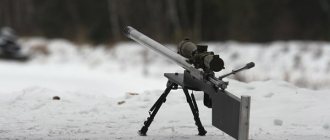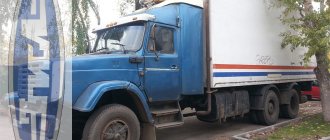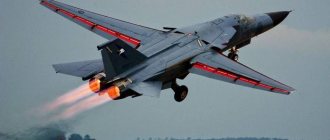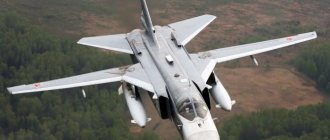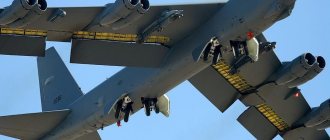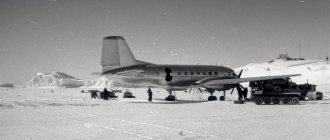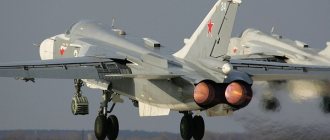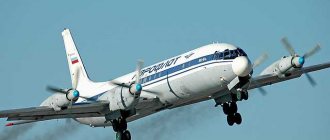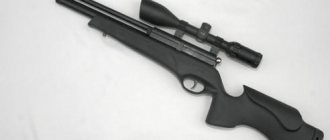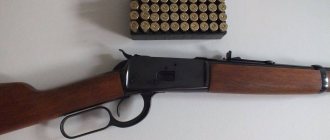Il-28 is the first Soviet front-line jet bomber. The aircraft was developed in 1948 and already in the 1950s became the solid core of Soviet front-line bomber aviation.
The Il-28 fuselage is made of D16 grade duralumin. The cabin on the aircraft is completely soundproofed and sealed in accordance with operating conditions. The aircraft has a three-post landing gear, including a nose gear. The landing gear is retracted according to a rather original scheme: the front one is retracted back inside the fuselage, while the other two are retracted forward into the nacelles. The Il-28 front-line bomber has two VK-1 engines located in special nacelles under the wing.
The aircraft's bomb armament, in accordance with the bomb load, includes 12 FAB-100 (100-kilogram high-explosive aircraft bombs), or 8 FAB-250 bombs, or 2 FAB-500 bombs, or one FAB-1500 bomb, which are installed under the fuselage.
Flight characteristics of the Il-28 front-line bomber:
- Crew: 3 people
- Length: 17.6 m
- Wingspan: 21.5 m
- Height: 6.70 m
- Wing area: 60.8 m²
- Empty weight: 12,890 kg
- Curb weight: 18,400 kg
- Maximum take-off weight: 23,200 kg
- Engines: 2 × TRD VK-1A
- Thrust: 2 × 26.5 kN (2700 kgf)
- Top speed: 906 km/h
- Cruising speed: 700 km/h
- Practical range: 2370 km
- Ferry range: 2460 km
- Service ceiling: 12,500 m
- Rate of climb: 15 m/s
- Take-off length: 965 m
- Run length: 1700 m
- Wing load: 291 kg/m²
- Thrust-to-weight ratio: 0.31
- Armament: 2 × 23 mm NR-23 cannons along the sides at the bottom of the bow, 100 rounds per barrel
- 2 × 23 mm NR-23 cannons in the rear defensive turret of the Il-K6, 225 rounds per barrel
- Bomb load normal: 1000 kg
- Bomb load maximum: 3000 kg
History of the IL-28
The development of the Il-28 front-line jet bomber took place in an atmosphere of fierce competition with the separate design bureau of Tupolev. It was decided to make the fuselage of the aircraft from duralumin alloy D16, developed in 1946. In 1948, a government decree was issued ordering the creation of the first model of the aircraft. On July 8, 1948, the Il-28 bomber made its first flight. However, it is worth noting that the first flight was carried out on a machine with installed engines. That is why state tests of the model began only in February 1949 - after the installation of domestic VK-1 engines.
During state tests of the Il-28 front-line jet bomber, the commission discovered about 80 defects, the correction and elimination of which, even in emergency mode, took about four months.
In June 1949, the question arose about which model should be adopted as the first Soviet jet bomber: Il-28, Tu-73 or Tu-78. Having carefully read the opinions of experts and weighed all sides of the issue, I.V. Stalin adopted the Il-28. It was June 1949 that was an important milestone in the history of the aircraft, which soon became the most popular jet bomber.
About engines
The underwing nacelles became the location of the VK-1 power units. To control the engines, the aircraft has cable wiring. During startup, each VK-1 is spun up using an electric starter. The fuel system consists of fuselage soft rubber tanks. Their total capacity is 7908 liters. Only the left engine is equipped with a hydraulic pump. If the hydraulic system suddenly fails, the flaps are lowered from the pneumatic system and the wheels are braked emergencyly. Also, with the help of air, the cargo compartment, namely the bomb bay doors, opens. Both engines are equipped with pneumatic pumps. In addition, the Il-28 has emergency cylinders containing compressed air.
Modifications of IL-28
There are 17 modifications of the Il-28 bomber:
- Il-28 – jet front-line bomber;
- Il-28A is a front-line bomber with a fuselage equipped to be armed with RDS-4 Tatyana tactical nuclear bombs;
- Il-28ZA - an aircraft equipped for atmospheric sounding (weather reconnaissance);
- Il-28LL is an aircraft equipped as a flying laboratory;
- Il-28M is a radio-controlled aircraft intended for use as a target in air defense exercises;
- Il-28P – “postal” modification of the aircraft;
- Il-28PL - an aircraft equipped for anti-submarine warfare;
- Il-28R – front-line reconnaissance aircraft;
- Il-28RTR is an aircraft designed for electronic reconnaissance;
- Il-28REB is a modification designed for electronic warfare;
- Il-28S is an experimental modification equipped with a swept wing and VK-5 engines;
- Il-28T is an experimental torpedo bomber model that was not put into service;
- Il-28U – training modification of the aircraft;
- Il-28Sh – jet front-line attack aircraft;
- Il-28 (UAV) is a radio-controlled modification of the aircraft. Development continued from 1956 to 1958 and was not completed;
- Il-28 on tracked traction – a modification of the aircraft to expand its operational potential in various conditions;
- IL-28 for towing targets - this modification has a modified fuselage: there is no aft rifle installation, instead of which a 2800 m long cable is attached, intended for towing a target.
About production
Serial production of the aircraft was organized in Moscow at plant No. 30, Voronezh (No. 166) and Omsk (No. 64). Additionally, the Il-28 was also produced at factories No. 1 and 18. In 1950, an aircraft unit was ready for training purposes. In the technical documentation it is listed as Il-28U. A year later, they created an aircraft for transporting torpedoes (Il-28T). Reconnaissance missions were to be carried out using the Il-28R aircraft. In total, the military industry of the Soviet Union produced at least 6,300 units. Silver paint was used to paint airplanes. Il-28s exported to other countries were painted with various types of camouflage. The dashboard was painted black, the chassis and cargo compartment were painted grey. According to aviation experts, it happened that cargo compartments and niches were only primed.
IL-28 in service
Almost immediately from the moment it was put into service, the Il-28 aircraft proved itself to be excellent and earned the well-deserved love of pilots. Thus, one of the most important advantages of the Il-28 was that the car was easy to operate, and piloting errors did not have a critical impact on the flight. Simply put, the IL-28 “forgave” many of the pilot’s mistakes, which made it possible to avoid a disaster.
Along with its operation in the USSR, the Il-28 front-line bomber was also supplied to the People's Liberation Army of China. A few years later, China mastered the production of Il-28 at a plant in Harbin. The Chinese model was designated N-5. Several N-5s were purchased from China by Romania. Another country that mastered the production of a copy of the Il-28 was Czechoslovakia. There, copies of the Il-28 were produced under the designation B-228.
It is worth noting that the aircraft was widely used by the countries participating in the Warsaw Pact, as well as by countries that had a political course friendly towards the Soviet Union. In 1955, the USSR delivered a batch of 30 Il-28 tactical bombers to Egypt, where it was repeatedly used during combat operations (for example, during the war of attrition with Israel in 1967-1970).
Also, a batch of Il-28s was delivered to Afghanistan, where they were armed with the 335th mixed air regiment. During the period of the democratic republic in Afghanistan from 1978 to 1992, the aircraft also participated in battles with rebels. During these battles, the Il-28 proved to be a successful and reliable vehicle. Also, as target towing vehicles, four Il-28s were purchased from the USSR by Finland.
And if in some countries the Il-28 was in operation until the 90s of the 20th century, then in the USSR the aircraft basically began to be replaced by the more modern multi-purpose supersonic aircraft Yak-28 already in the mid-50s. At the same time, some regiments armed with the Il-28 were “transplanted” to the heavy multi-purpose Tu-16. By the end of the 1950s, the Il-28 front-line jet bomber was removed from service with the Soviet Army. After this, the IL-28 was found mainly only in the armies of the countries of the socialist camp.
However, decommissioning does not mean that the Il-28 ceased to be used in the Soviet Union. Thus, the machine was also used for civilian purposes, for example, for retraining Aeroflot pilots, as well as as part of postal aviation.
Armament
Of the wide range of Il-28 bombs, FAB-100 (12 units) or FAB-250M46 (8 units) were most often used. In some variants, two FAB-500M46 units or one FAB-1500M46 were considered. The Il-28T (torpedo bomber) was armed with one RAT-52 rocket torpedo or AMD-500, AMD-1000 mines of the “Desna” or “Lira” type. The IL-28T used the PTN-45 sight. Small arms included 2 fixed type HP-23 guns and 2 mobile Il-K6 cannons. The latter were hydraulically driven.
Aircraft that served in the USSR Air Force or Navy were painted silver, those sent for export were painted in different camouflage colors.
The aircraft was operated in many countries, in particular in China, Egypt, Romania, Algeria, Finland, Bulgaria, Czechoslovakia, East Germany, Afghanistan, North Korea, Vietnam, Yemen, Cuba, Morocco, Somalia, Indonesia, Nigeria and Syria.
By the end of the 50s, the aircraft began to be removed from service and replaced with the Yak-28.
Strengths and weaknesses of the IL-28
As already mentioned, the main advantage of the Il-28 front-line jet bomber is its high reliability, as well as the fact that the machine “forgives” many mistakes when piloting or outright “aerial hooliganism”. It was this aspect of the IL-28 that made it possible to reduce the level of disasters involving it to a minimum.
The duralumin alloy used in the fuselage structure has high strength and is characterized by a relatively low weight. The VK-1 engines, which were installed on the aircraft, made it possible to reach a speed that was practically not inferior to similar models designed abroad. The maximum bomb load of 3000 kg allowed the use of a very wide arsenal of bomb weapons. Thus, the Il-28A modification even had the possibility of arming itself with the RDS-4 Tatyana tactical atomic bomb.
The main factor that provided the IL-28 with high flight performance is that its development began immediately after the Great Patriotic War. When developing the aircraft, many factors of air combat were taken into account, as well as numerous opinions of experienced pilots.
However, it should be noted that the machine also had a number of shortcomings that were revealed during its operation. The main disadvantage of the Il-28 front-line jet bomber was that when flying in rainy conditions, the glass of the aircraft's canopy became covered with a layer of moisture, which seriously complicated the pilot's visibility. The windows also fogged up during takeoff and landing, which also caused additional inconvenience.
Another disadvantage of the Il-28 was that at temperatures below zero, the aircraft’s radio antenna and part of the fuselage were subject to icing, and this led to disruption of the aircraft’s radio communications. There was a serious temperature difference in the cockpits of the pilot and navigator (up to 35 degrees in summer and up to minus 30 in winter). The instability of aircraft control using the autopilot at high speeds led to a significant decrease in the accuracy of approach to the target and, as a consequence, bombing.
However, despite all the shortcomings, the car earned the love of pilots, both experienced pilots who went through the war and cadets.
About the design
An aircraft with a pressurized and soundproofed cabin, a straight two-spar monoblock trapezoidal wing. Its mechanization is carried out by means of conventional flaps, which are deflected at an angle of 50 degrees during landing and by 20 during takeoff. Made from duralumin alloy D16T. The ailerons were used to control the aircraft's roll. The IL-28 is equipped with a symmetrical fin and Naca-00 stabilizer. The rudder and ailerons are electrically controlled. The PB trimer is adjusted using mechanical cables and gear mechanisms. The aircraft was equipped with two GSR-9000 DC starter-generators and two 12-A-30 batteries, which were used in the aircraft as a source of electricity.
TTX
The bomber has the following tactical and technical characteristics:
- Wing span – 2150 cm, height – 670 cm.
- The total wing area is 60.8 square meters.
- The fully equipped aircraft weighs 18,400 kg, empty - 12,890 kg.
- The crew consists of three people.
- The maximum take-off weight is 23,200 kg.
- The aircraft is powered by two VK-1A turbojet engines with a thrust of 2700 kgf.
- At maximum speed, the IL-28 covers 906 thousand meters per second, and at cruising speed – 700.
- The practical range of the bomber is 2370 km, the ferry range is 2460.
- The aircraft with a take-off run of 965 m has a climb rate of 15 m/s.
- Each wing experiences a load of 291 kg/m2.
- The minimum load in the bomb bay is 1 thousand kg, the maximum is 3 thousand kg.
- The Il-28 is equipped with two 23 mm caliber NR-23 cannons in the bow compartment and two NR-23 cannons in the stern.
Notes
- Yakubovich N.V.
Ilyushin aircraft. The best of the best. - M.: Yauza; EKSMO, 2009. - P. 213 - 480 p. — (War and us. Soviet aviation) — ISBN 978-5-699-33921-1. - Dayan Moshe, Tevet Shabtai. Arab-Israeli wars 1956,1967. - M., 2003, pp. 122-123.
- Vic Flintham. High Stakes: Britain's Air Arms in Action 1945-1990, Pen & Sword Aviation, 2009, p.209
- N. Yakubovich, The first jet bomber Il-28. Stalin's atomic “butcher”, p.70
- Shlomo Aloni, Israeli Mirage and Nesher Aces, p.82
- Post-war attack aircraft. A. Kotlobovsky
- ↑ Yakubovich N.V.
Bomber Il-28. Part 2. // Aviation collection (supplement to the “Modeler-Constructor” magazine). - 2006. - No. 6. - P. 27-30. - ↑ Egorov Yu. A., Kotlobovsky A. V.
.
A successful plane that had bad luck. // Aviation and time
. - 1997. - No. 1. - P. 16-20. - ↑
- Robert F. Kennedy
Thirteen Days. A Memoir of the Cuban Missile Crisis. - New York: W. W. Norton and Company, 1969. - P. 27.
Aviation accidents involving an aircraft
Memorial sign at the site of the disaster on September 12, 1957
On September 12, 1957, the Il-28 crashed during a test flight near the village of Pokrovskoye, Moscow Region (now the Voronovskoye settlement of Moscow). Three people died: test pilot 3rd class K. B. Kabatov, test navigator V. B. Goremykin and flight radio operator I. N. Ponkratiev.
On the night of January 21-22, 1958, an Il-28R reconnaissance aircraft crashed into Mount Naiboretskaya in the Dolinsky district of the Sakhalin region during a training flight while landing. All four crew members were killed.
On October 27, 1976, when landing at the airfield of the Tambov VVAUL in conditions of deteriorating meteorological minimum, an Il-28 crashed under the control of the head of the school, Major General of Aviation Yuri Aleksandrovich Eremeev, and the navigator - the head of the political department of the school. We flew to the training regiment in Michurinsk (15-20 minute flight). The air gunner-radio operator was not taken on the flight, and when he returned home late at night, his wife, seeing him through the peephole of the door, fell unconscious twice. Already in our time, in memory of General Eremeev Yu.A. A square in the former military camp of the school is named after him.
About radio equipment
The IL-28 was equipped with the PSBN-N radar system, ARK-5 radio compass, RV-2 and RV-10 radio altimeters, RSIU-ZM radio stations, SRO radar transponder and SPU-5 intercom. Aircraft designed to perform reconnaissance missions are equipped with photographic equipment: three AFA-33, AFA-BA-40, AFA-75MK. The IL-28 has a FRL-1M photo attachment, with the help of which information is recorded from the screen of the radar system. In December 1953, a government decree was issued according to which the PSBN was replaced by the Kurs radar. Reconnaissance aircraft have containers containing ASO-28 dipole reflectors and special “Sodium” equipment, the task of which is to reproduce radio interference.
Surviving copies
| Photo | Type | Board number | Location |
| IL-28 | 40 | Tokmak, Chui region, Kyrgyzstan | |
| IL-28 | 38 | Skulte, Latvia | |
| IL-28 | 16 | Central Museum of the Armed Forces, Moscow | |
| IL-28 | Museum of the Irkutsk Aircraft Plant, Irkutsk | ||
| IL-28 | 07 | Museum of the Air Force of the Northern Fleet, village. Safonovo, Murmansk region | |
| IL-28 | 01 | village Katunino, Arkhangelsk region | |
| IL-28 | 01 | The area named after Gagarina, Orsk | |
| Il-28R | 33 | Main branch museum of the history of civil aviation, Ulyanovsk | |
| Il-28R | 01 | Museum of Technology of Vadim Zadorozhny, Moscow region | |
| Il-28R | 01 | Long-Range Aviation Base of the Russian Air Force, Tambov | |
| IL-28 | 04 | Central Museum of the Russian Air Force, Monino | |
| IL-28 | 08 | Petrovsk, Saratov region. | |
| Il-28U | without b/n | st. Ilyushina, Vologda, Vologda region | |
| IL-28 | 15 | military unit 95109, Vyborg | |
| IL-28 | 21 | Alley of Aviators GLAU, Kropyvnytskyi, Ukraine | |
| IL-28 | With. Chaikino, Dzhankoy district, Ukraine | ||
| IL-28 | 26 | With. Volnoye, Dzhankoy district, Republic of Crimea | |
| IL-28 | 30 | Baltimore airfield, Voronezh | |
| IL-28 | 30 | CHVVAUSH, Chelyabinsk | |
| IL-28 | 42 | Chernyakhovsk, Kaliningrad region. | |
| IL-28 | 55 | village Chkalovsk, Kaliningrad region. | |
| IL-28 | 01 | Krechevitsy airfield, Novgorod region. | |
| Il-28U | 0501 | Prague, Czech Republic | |
| IL-28 | 6926 | Prague, Czech Republic | |
| Il-28R | 2404 | Letecke Historicke Spolecnosti, Viskov, Czech Republic | |
| IL-28 | 4 | Poznan, Poland | |
| Il-28R | 72 | Polish Aviation Museum, Krakow-Rakowice, Poland | |
| Il-28U | S3 | Polish Aviation Museum, Krakow-Rakowice, Poland | |
| IL-28 | 10 | Witkowo, Poland | |
| IL-28 | 47 | Lodz, Poland | |
| IL-28 | 52 | Kolobrzeg, Poland | |
| Il-28R | 69 | Polish Navy Museum, Gdynia, Poland | |
| Il-28R | 65 | Muzeum Katyńskie w Warszawie, Warsaw, Poland | |
| Il-28R | NH-4 | Central Aviation Museum, Finland | |
| Il-28B | 208 | Bundeswehr Aviation Museum, Berlin, Germany | |
| IL-28 | 50 | War Museum, Jonow, Poland | |
| IL-28 | Trekhgorny "s/c Stone Flower", Russia, Chelyabinsk region. | ||
| IL-28 | 30 | Shagol (airfield), Chelyabinsk, Russia | |
| IL-28 | 7 | Parco Tematico-Museo della'Aviazione, Rimini, Italy | |
| Il-28R | 43 | Plovdiv, Bulgaria | |
| IL-28 | 55 | Szolnok, Hungary | |
| Harbin HJ-5 | 408 | Fetesti, Romania | |
| Harbin H-5R | 308 | Fetesti, Romania | |
| Harbin H-5 | Bacau, Romania | ||
| IL-28 | 405 | Bucharest, Romania | |
| IL-28 | 038 | Cheongju, South Korea |
